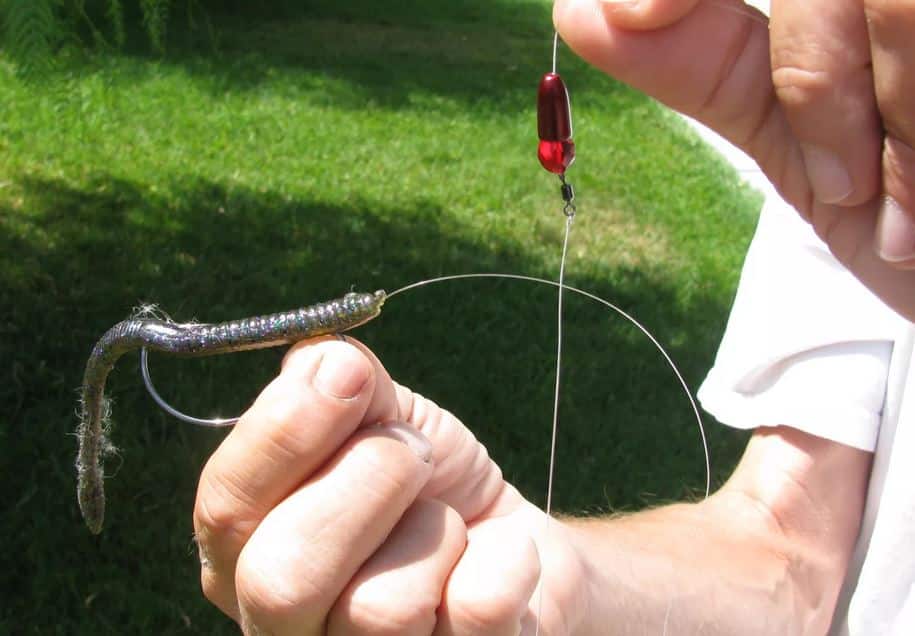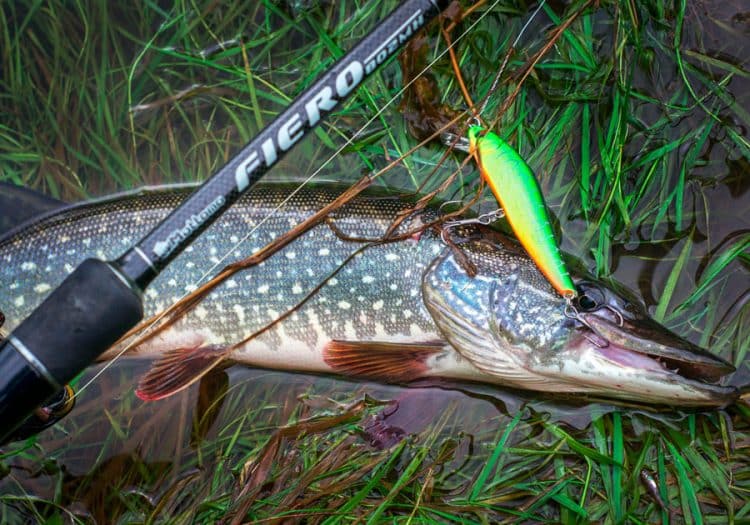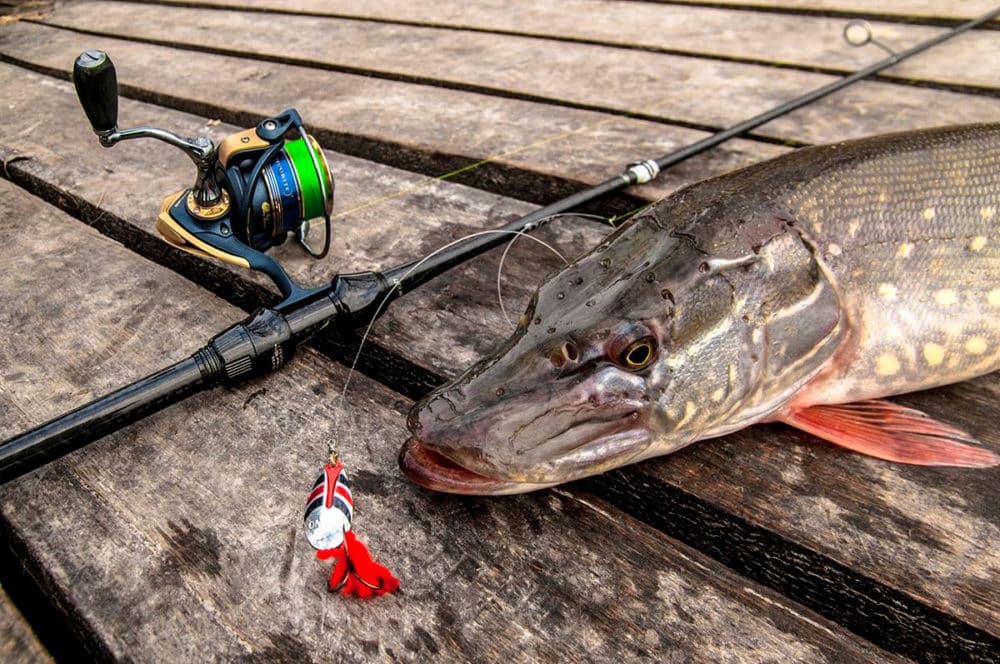The bottom overgrown with vegetation, abrasive sand, shell and stone, a pit heaped up with snag, silty litter, branches and foliage that has fallen to the bottom – all these are the favorite sites of predatory fish. But here’s the bad luck, getting it out of there with an ordinary jig is difficult, costly and nervously. In such difficult and at the same time promising places for fishing, it is relevant to use Carolina rig (Carolina rig,
carolina rig), which belongs to those types of spaced mounting that will pass fire, water and copper pipes and is inexpensive, and even a beginner can install it. … Karolinska is rightfully considered one of the most passable rigs. In terms of cross-country ability, only Texas Rig can compete with the
Carolina, but the installation, conditions for optimal use, as well as the advantages and disadvantages of these rigs are different. We can say that Carolina Rig = Texas Rig + leash.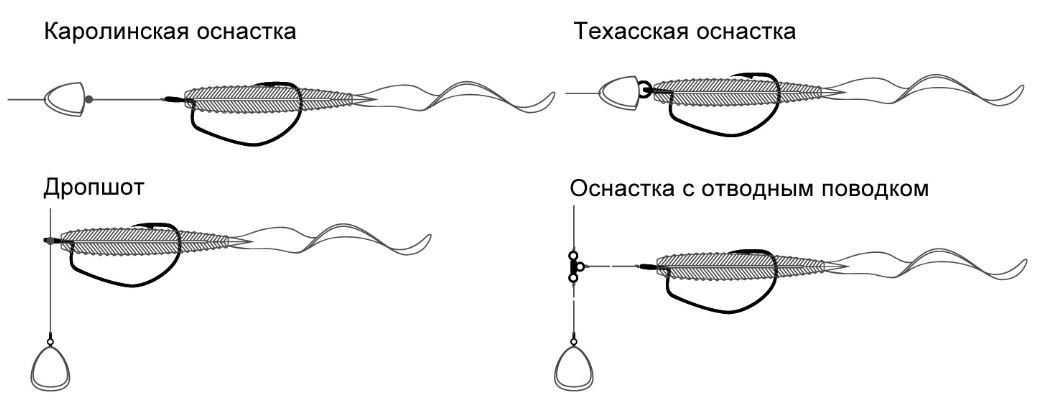
There is no perfect bait and rig for fishing, but there is the right one for the specific circumstances.
- What does it look like (with photos and videos underwater) and what can a Carolina rig look like?
- Carolina rig installation: what bullets and beads to choose, how to tie carolina correctly
- What is needed for manufacturing
- How to choose a lead
- How to choose a hook
- How to choose a bead (s)
- How to choose a swivel
- How to choose the leash material, its length and thickness
- How to assemble a rig assembly
- Classic Carolina rig
- Improved Carolina rig on a two-piece leash
- Mounting options for Carolina rig when fishing for different predators
- In what conditions the installation of CarolinaRig is especially good
- What baits are used
- How to fish with a Caroline rig: casting, posting technique, river and calm water fishing
- What kind of tackle is needed?
- Form
- Coil and cord
- Поделиться ссылкой:
What does it look like (with photos and videos underwater) and what can a Carolina rig look like?
Carolina rig is a subspecies of the classic Texas rig, but with some modifications that affect the application of this type of installation, as well as the behavior and animation of the bait. It is a spaced jig rig, where between the sliding lead and the bait on the offset carrier there is a fluorocarbon leash connected to the main braid through a swivel.
- Efficiency in passive fish , due to the fact that you can fish a promising water area with slow types of animation with long pauses and lazy dragging, practically forcing the grip of a predator that is not hungry as a whole because of his anger at uninvited guests – worms or fry.
- High passability among stones, pebbles, shells, underwater vegetation and along sandy ridges . But on the snag it is better to use texas.
- Can be fished at any adequate depth . The size of the load does not interfere in any way with the predator’s bite. Due to the fact that it is sliding and spaced from the bait at a distance, the fish does not feel resistance when biting.
- From the previous point, the next one – when using edible rubber, you can give the fish time to swallow the bait well – to pause on the bite. This is possible since the predator does not feel the trick.
- Ease of installation . Slightly more difficult than texas, but still easier than other layouts.
Carolina rig installation: what bullets and beads to choose, how to tie carolina correctly
What is needed for manufacturing
For manufacturing, you will need a spinning tackle (the requirements for it are below). And also: weights of different weights, fluorocarbon in different unwinding, offset hooks, beads, swivels and a little knowledge.
How to choose a lead
The weight for the Carolina rig is almost always a sliding bullet, and only in the absence of such – an olive or an eared bullet. According to the classics, foreign colleagues use bronze, brass, tungsten as a material for bullets. They are more sonorous when hitting a bead, which, supposedly, is an additional motivation for the fish to grip. There is also an opinion that due to the fact that they do not crumple, unlike lead, they get stuck less among stones, but this is a very controversial fact, which has not been verified in practice.
We
did not find any such studies… Our fishermen are not so rich and not so aesthetes, and therefore – the good old lead is in favor. The weight is selected exclusively in the same way as in classic jig fishing, based on the depth of the reservoir, the strength of the current and the required casting distance.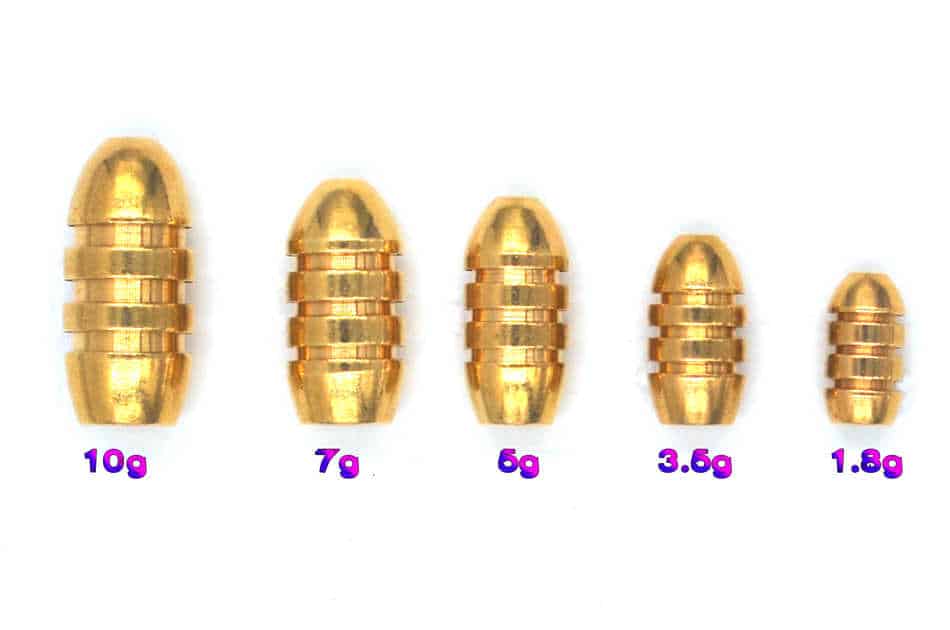
brass (bronze plus minus) <lead <tungsten . Therefore, we would advise using tungsten in most cases, but if there is such a possibility.
How to choose a hook
In 99 percent of cases, an offset hook is used, since the carolina is used in difficult conditions, and therefore it makes no sense to put ordinary hooks. The size, height, shape is dictated by the baits used. You should always have a set of offsets for different spinning conditions.
How to choose a bead (s)
Beads are needed to protect the nodal connections from the aggressive effects of the load sliding along the fluor. The bead should not shatter when hit by a bullet, and ideally if it makes a clicking sound when exposed to a weight.
Some colleagues consider the acoustic effect to be insignificant, or even far-fetched, but other experts, for example, the Shcherbakov brothers, hold a different opinion and recommend using sounding beads made of brass and other sonorous materials in combination with a weight of the same composition.
How to choose a swivel
The swivel should first of all fit into the general canvas of the tackle, that is, correspond to all its other parts. Don’t be too small or too big. It is also important that it is of high quality and works well even on the slowest lines, otherwise the twisting of the line cannot be avoided.
Pay attention to the bearing swivels!
How to choose the leash material, its length and thickness
Fishing takes place in an aggressive environment, therefore, for catching pike perch, perch and other predatory fish, in addition to pike, we use wear-resistant fluorocarbon, for toothed fish we use flexible leash material without fail. The length and thickness are selected based on the type and activity / passivity of the fish, as well as the fishing conditions.
How to assemble a rig assembly
When installing the Carolina onast, it is important to take into account two nuances. The first is that the leash should be exclusively from fluorocarbon, in view of the fact that fishing has to be done in difficult conditions, when the final part of the rig is constantly exposed to the abrasive effect of sand, shells, stones, gravel, snags, etc. And it is the fluor that is best suited for such conditions, while the braid quickly deteriorates. The second is that the bullet sinker (or olive) constantly slides along the main line, which is also extremely bad for the line, and this part of the rig must also be based on fluor. There are two options:
- First. The main line is also fluorocarbon of a thicker diameter than the lead part of the carolina.
- Second. If the braid is used as a base, then you need to tie up an additional part of the fluor, along which the weight will slide .
Classic Carolina rig
The first option is classic, when the weight is located on the main line.
Some anglers do this with braid as a base, but we do not recommend it for the reasons stated above.
So, as a basis, fluor 0.3-0.4 mm. We pass a bullet-shaped sinker of the required weight with the nose to the tip of the rod. Then we select the bead so that it fits snugly into the bullet’s recess. We take a swivel of high quality and commensurate with all the equipment and tie it after the bead with one of the clinch, reverse clinch, double clinch, palomar knots. To the other part of the swivel, through the same knot, a fluor leash is tied, which is 0.05 mm thinner than the main one. That is, approximately 0.22-0.3 mm. The length of the leash is selected empirically and depends on the activity of the fish, the speed of the current, the depth of fishing and the ability to cast.
There is an opinion! Many inveterate spinning anglers recommend using a leash of at least 1 meter for the carolina. Especially if the fish is extremely passive. There is a reason to listen, as the opinion is very widespread and is expressed by experienced athletes and just practitioners.
In general, along the length of the leash, one should adhere to such not dogmas, but the rules:
- the more passive the fish, the longer the leash and vice versa;
- the stronger the flow rate, the longer the leash and vice versa;
- the deeper the water area, the longer the leash (and the larger the lead);
- a long lead reduces casting opportunities, especially when fishing from overgrown banks and this must also be taken into account.
An offset hook is tied to the second part of the leash and then the bait is put on.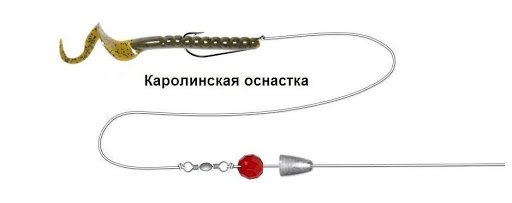
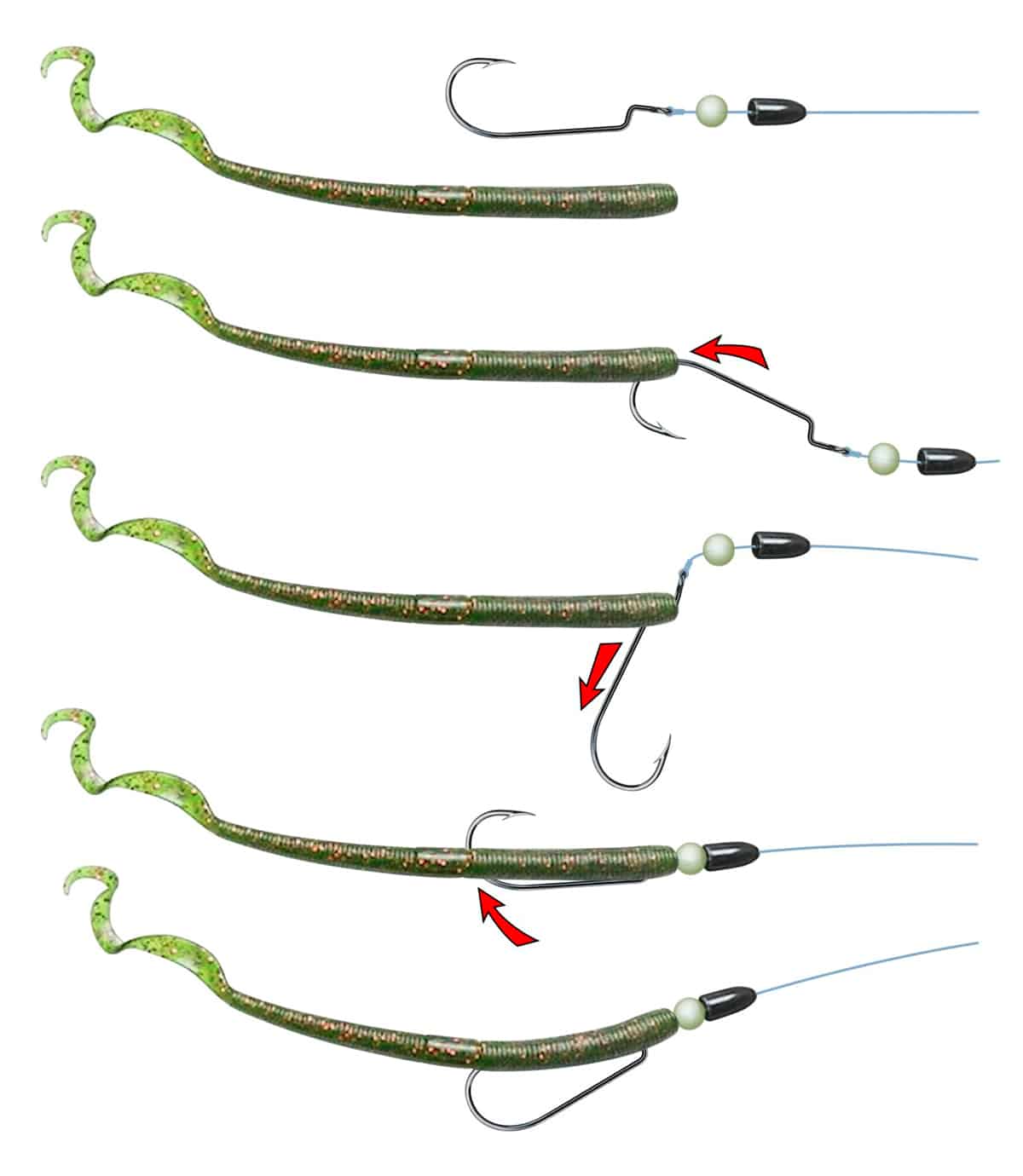
We select the length of the offset hook for the size of the bait, the width for the type of silicone – the more it is driven, the lower the offset and vice versa. It is important that the tip of the hook is hidden in the back of the bait, but at the same time, when biting, it is easily squeezed out.
Improved Carolina rig on a two-piece leash
Such installation is used by avid and experienced spinningists if a braid is used as the main fishing line. In this case, we make two cuts of fluor, 50-60 cm each. We attach two obtained cuts to the swivel at different ends. Knots – clinch, palomar. We put on a bead for one segment, then a bullet, with a notch to the bead and another smaller bead on top. This part (in the photo below on the right) will be further attached to the main cord through a knotless knot, a carrot knot, or through another swivel. An offset hook is tied to the second part of the two-part leash and the bait is attached – everything is the same as in the method described above. As a result, we get the following installation: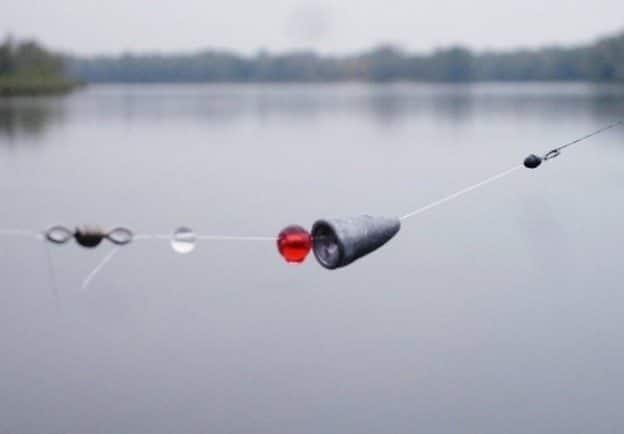
Of the minuses, there are more fittings, which means more likely to break off, plus not the best option for fishing in mud and algae-snot, which strive to stick around all the equipment.
Mounting options for Carolina rig when fishing for different predators
Carolina pike rigs
should contain a leash made of soft leash materials at the end. Especially if the catch of this predator is purposeful. It fits all the same, only in the final part a leash up to 30-40 cm from a soft one is placed! (this is important) material. Also, heavier weights and larger baits are usually used, which is due to the habits and places that the pike chooses for hunting.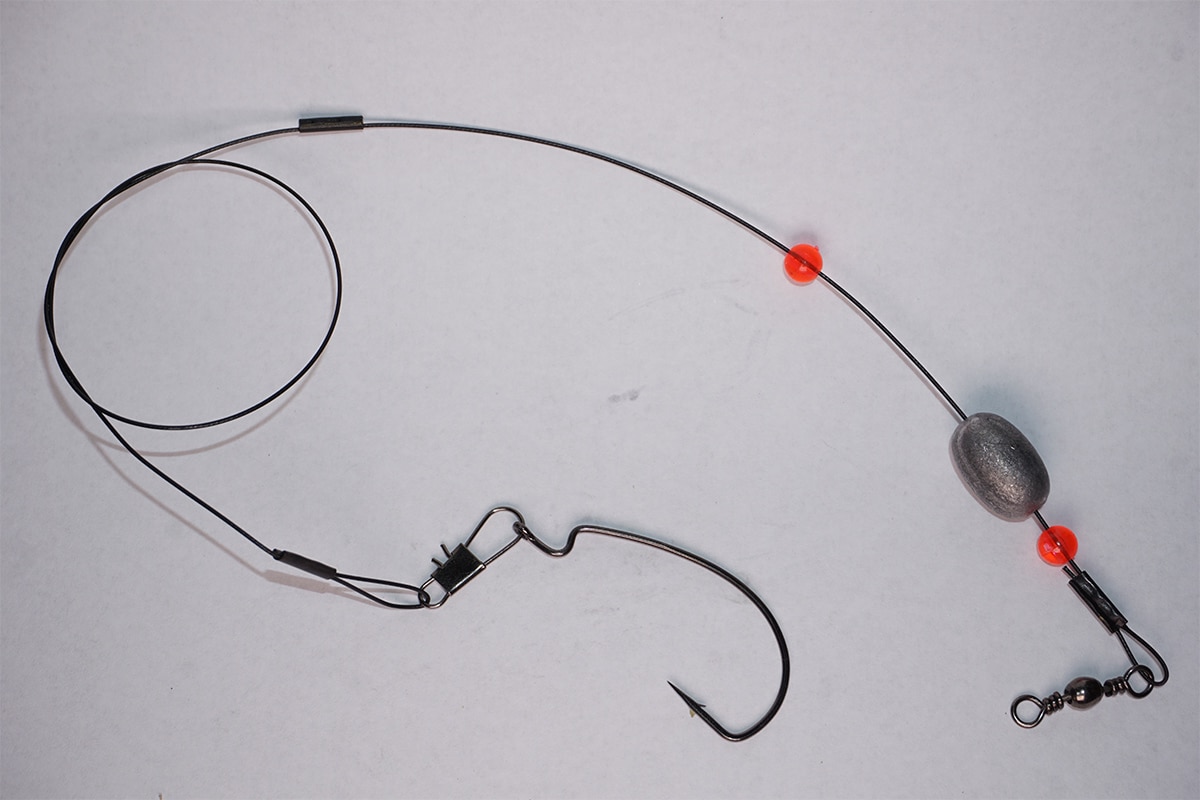
perch , especially passive, use the longest leashes from a meter or more. A diameter of 0.2-0.25 mm is almost always sufficient. Lures 2-3 inches on matching hooks. If the target is
walleye, then when installing the Carolina rig, it is worth considering where the fishing will go. In general, the leash is used shorter than for perch fishing, but thicker. Diameter 0.25-0.35 mm. The baits are also larger. Making a Carolina rig step by step clearly in the video: https://youtu.be/PCYxTh01XVM
In what conditions the installation of CarolinaRig is especially good
Karolinska tackle is used when catching a passive and inhibited predator. In the middle latitudes of the CIS and the Russian Federation, it shows itself well in early spring and summer, as well as throughout the year at the points where you need to fish the water area as slowly and with emphasis as possible. For example, such places include pits and edges littered with garbage when fishing for pike, rifts overgrown with grass and small algae and places near them when fishing for perch, gravel and rocky places where pike perch often hunt. Due to the fact that this is a classic non-hook with an emphasis on animation – dragging along the bottom, it works great in difficult conditions of an aggressive and overgrown bottom. Can be used among reeds, water lilies, over pebbles and sand.
What baits are used
Worms, slugs, crustaceans, nymphs, vibrotails and twisters are used for fishing with carolinka. Often – runny, as more passable and almost always edible. Many anglers prefer passive types of lures, in view of the fact that the posting technique involves constant impact on the lure with a rod and a reel – dragging, tossing, light twitch … It can be used as a normal sinking silicone, then it will drag along the bottom or jump, Like a jig on the step, if the angler so desires. Or floating silicone, then it will float at some distance from the bottom (
pelagic), animating after the spinning player’s actions. It is important that the bait is made of durable silicone – on the carolina the bait also suffers, especially its nose, which is often torn off by offset when fish bite, hit against stones and driftwood.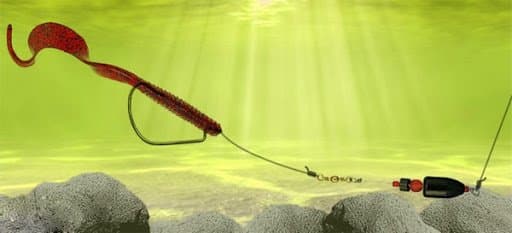
How to fish with a Caroline rig: casting, posting technique, river and calm water fishing
The Carolina rig is especially effective on bodies of water without a current and in a slow current. It is in such conditions that Carolina shows her best side, allowing her to animate the bait as lazily as possible, dragging it along the bottom and playing along with the tip of the rod. On holes and entrances to them, on dumps in depth, on the edges, sharp and smooth changes in depth, you can work out the bottom with a high quality, if you choose the right load. In such places, pike and large perch often stand in ambush behind underwater vegetation or snags. On the pike, the basic wiring of the Carolina works – uniform propelling with pauses and accelerations. Perch responds well to all sorts of twitchy motives in animation. And, of course, when fishing for pike perch and perch on a rocky pebble bottom, trapped by shell rock, the Carolina rig is second to none. Animation – even dragging along the bottom with pauses,wavy step, uniformity with tucking with the tip of the blank. On the current, in contrast to the usual jig, a good result is given by casting across and on the course of the current, so that the lure is dragged towards itself. The weight of the bullet is selected in such a way that the bait does not squeeze out to the surface during wiring, but it goes along the bottom.
It should be noted that in a strong current it will be more effective to use a
diverter leash or texas.
Fishing for perch with a Caroline rig: https://youtu.be/SQqnETf9uxY
What kind of tackle is needed?
The tackle is selected taking into account the fact that it is, albeit non-standard, but still jig fishing.
Form
This means that you need the most sonorous and responsive form, responsive and transmitting all the movements of the angler to the bait and all the movements of the bait and fish biting in the opposite direction. Build – fast. The test is selected based on the standard fishing conditions in your area. In most cases, two blanks are sufficient to cover the entire test range. 2-15 and 5-30 grams. For those who fish in large reservoirs and rivers, a more powerful blank with a dough up to 60 grams and more is needed. The length is matched to the anatomical data, fishing conditions. Station wagon 2.4-2.7 meters.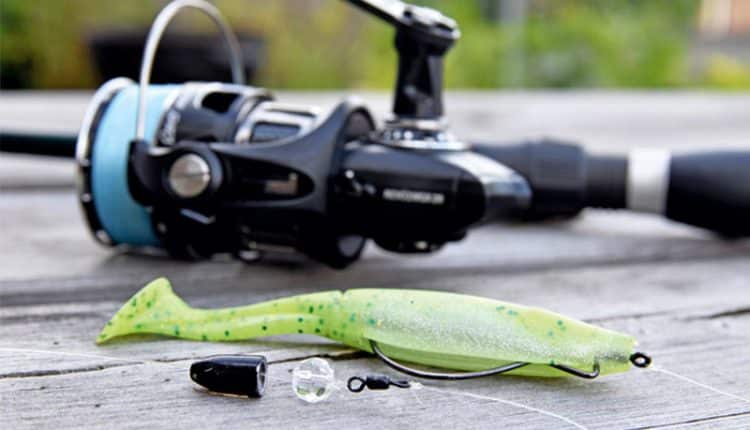
Coil and cord
If a braid is used as a base, we recommend using a 2000-2500 Shimano spinning reel with high-quality cord laying and without dropping loops on aggressive types of animation. The diameter of the main braid is 0.12-0.18 mm. If the basis is fluor, then only the multiplier. Meat grinders with thin fluor diameters (and most often used in a diameter of 0.22-0.35) work mediocre, overlaps and loops often occur. Is the beautiful Carolina rig a panacea? Well no. The number one jig wheel choice? No again. Carolina is just a tool that, in skillful and understanding hands, under certain conditions, can come to the fore, leaving behind the classics of jig, leash eared rigs and other methods by which spinning players try to deceive an increasingly sophisticated predator.
